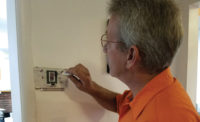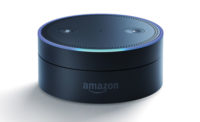HVACR is not always thought of as a forward-thinking industry, especially in regards to the actual services provided by technicians. The phrase “if it ain’t broke, don’t fix it” comes to mind, and it is certainly true that many contractors and technicians have done things a specific way, with a specific set of tools, for a long period of time and see no reason to change a proven strategy.
However, others are looking toward the future with innovation in the form of wearable technology. Google Glass, an optical head-mounted display that looks like a pair of eyeglasses and has smartphone-like capabilities, was introduced in 2014, bringing with it all sorts of potential job site applications for HVAC technicians.
Each of Franklin, Tennessee-based Lee Co.’s field technicians is equipped with these or similar smart glasses, which allows younger technicians to make video calls to seasoned technicians for video support, record video for customers to watch, and take photos while the work is being done.
This technology also allows technicians to enhance their skills and abilities while, at the same time, granting customers an easier understanding of the work being done inside their homes or commercial spaces.
“Change is not common for field guys, and they don’t always like it,” said Steve Scott, vice president of facilities solutions, Lee Co.
“I just knew that [wearing smart glasses] was something that would disrupt their workflow on a daily basis,” continued Scott. “I integrated other new technologies into the field over the last few years and they’ve all been very well received. We’ll continue to integrate our vision going forward.”
On the other side of the country, Las Vegas Air Conditioning Inc. in Las Vegas, is using a wide array of devices to diagnose, troubleshoot, and fix equipment.
Company owner, Stephen Gamst, said his repair technicians carry tools such as Google Glass and Epson Moverio, and it’s the software that separates them.
“Depending on the job, technicians simply put on their glasses and go to work diagnosing the air conditioner hands-free while a tiny camera in the glasses records every move and simultaneously broadcasts the footage to a senior repair technician back at the main office.
“In the main office, we can watch and even draw on our screen to illustrate a repair. The field tech can see our drawing displayed in front of him in real-life 3-D, like watching a 65-inch TV right as a display is in the lenses,” continued Gamst. “The footage is recorded and can be used for future training, proof of the work that was done, or to send to the owners or managers of a property who may be off-site.”
CUSTOMER RESPONSE
Having progressive technology at a technician’s disposal is a great advantage, but it could easily go for naught if customers feel uneasy or unsure about having these glasses in their homes. There have certainly been outspoken critics who have safety concerns, but Scott said most customers are extremely receptive to it, and are enthusiastic when they see technicians wearing them.
“Most people are accustomed to technological advances in many different ways, but not in our industry,” said Scott. “It’s been the same forever, and to see these guys walk in with glasses around their necks is exciting for customers. We wanted these things visible and to be out there to get the word out in the marketplace. Customers are excited to get service reports with a short narrative of what we have done and a recap with videos, pictures, etc.”
“People are people, some take to it and some don’t care,” said Gamst. “Nobody has ever been offended, but, then again, we never broadcast someone’s home or personal space without permission. Having us stream or broadcast is optional. But, if a technician needs tech support, nobody ever cares if a support representative comes in to help.”
For the customers who do latch onto the technology, they have opportunities to watch recap videos of completed work, receive detailed reports with photos, and even view live streams of what technicians are doing. Gamst noted his company even goes so far as to allow competitors to watch the streams and offer all forms of criticism.
“Allowing a competitor to watch you work is saying, ‘Go ahead and pick it apart,’” he said. “That’s what they want to do, so, yes, naturally, a live stream like that will only be performed by our senior technicians. But, for me, I started allowing other technicians to log in and watch, because it’s fun, and I enjoy it. It’s different from the whole ‘drive around and fix it’ routine. It’s given a new spark to repairing air conditioning systems. Plus, it can be rewarding to teach a new up-and-coming technician a new trick, regardless of what company he or she works for. If it’s good for the industry, it’s good for me.”
PASS IT ON
Smart glasses allow companies to see increased referrals and word-of-mouth chatter as it occurs. As it stands, only around 20 percent of Americans own some form of wearable technology, and only 10 percent actually wear it every day, so this is still a fresh concept for many people.
“We deployed our smart glasses the first week of January,” said Scott. “We pulled in workflows and integrated this technology over the course of eight weeks. We’ve had a couple of good months. I personally get emails from customers all the time that say how impressed people are with these glasses. I believe most of the feedback is kind of ‘water-cooler talk’, where people are excited about the technology and let their friends know about it.”
For Gamst, the smart glasses aren’t leading directly to referrals, for the most part, but they are leaving a lasting impression in the minds of customers.
“Customers are impressed that they can see what we are doing and that we’re doing it as seamless and transparent as possible,” he said.
Looking forward, Scott said that having technology like this is beneficial as it may make a company more apt to discover new and exciting tools and technologies in the coming years.
”We’re offering a technology-driven service platform. We aren’t replacing people with technology, though we’re doing more with the limited number of people we have due to the labor shortage. Technicians just aren’t as available as they used to be. Everyone understands this, and helping people be more efficient in the field is extremely important.”
Publication date: 5/30/2016
Want more HVAC industry news and information? Join The NEWS on Facebook, Twitter, and LinkedIn today!









